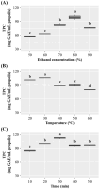Antioxidant, Antibacterial, and Bioaccessibility Properties of Ultrasound-Extracted Chilean Propolis
- PMID: 40563285
- PMCID: PMC12189508
- DOI: 10.3390/antiox14060651
Antioxidant, Antibacterial, and Bioaccessibility Properties of Ultrasound-Extracted Chilean Propolis
Abstract
Propolis is a honeybee product with significant biological properties, strongly influenced by geographic and floral origin as well as extraction method. Ultrasound-assisted extraction (UAE) is an emerging alternative for propolis preparation. This study aimed to determine the optimal UAE conditions for total polyphenol content (TPC) and total flavonoid content (TFC) in Chilean propolis and compare its antioxidant and antimicrobial capacities with a conventional method. UAE was performed with varying ethanol concentrations (50-90%), temperatures (20-60 °C), and extraction times (10-50 min), keeping the solid/liquid ratio constant at 1:10 (w/v). The optimal ethanolic UAE extract (OE) was compared to the conventional ethanolic extract (CE) for antimicrobial activity against Salmonella enterica and Listeria monocytogenes and antioxidant capacity (DPPH, ABTS, FRAP assays). Optimal UAE conditions were 80% ethanol, 30 °C, and 30 min. The OE showed significantly higher (p < 0.05) TPC (22.4 ± 0.3 mg GAE/mL), TFC (15.7 ± 0.7 mg QE/mL), antioxidant capacity (ABTS: 35.7 ± 0.9; DPPH: 62.9 ± 0.3; FRAP: 49.7 ± 2.1 µmol TE/mL), and antimicrobial activity in the evaluated Gram-positive bacteria (>15 mm inhibition halo, MBC = 3.1 mg/mL) compared to the CE. The bioaccessibility analysis revealed that the OE maintained 20.1% of its polyphenol content and 69.5%, 60.5%, and 61.9% of DPPH, ABTS, and FRAP, respectively, after simulated gastrointestinal digestion. The established optimal UAE conditions generated extracts with increased polyphenol content, antioxidant capacity, antimicrobial activity, and bioaccessibility, indicating its potential as an extraction method for propolis with enhanced bioactivity.
Keywords: bioactive properties; digestion; polyphenols; ultrasound-assisted extraction.
Conflict of interest statement
The authors declare no conflicts of interest.
Figures


Similar articles
-
Exploitation of Apulian Salicornia europaea L. via NADES-UAE: Extraction, Antioxidant Activity and Antimicrobial Potential.Molecules. 2025 Aug 13;30(16):3367. doi: 10.3390/molecules30163367. Molecules. 2025. PMID: 40871520
-
Optimization of Conventional and Ultrasound-Assisted Extraction to Maximize Recovery of Total Phenolic Content and In Vitro Antioxidant Activity from Crataegus almaatensis Leaves.Antioxidants (Basel). 2025 Aug 16;14(8):1003. doi: 10.3390/antiox14081003. Antioxidants (Basel). 2025. PMID: 40867899
-
Green Extraction of Antioxidant Polyphenols from Strawberry Tree (Arbutus unedo L. ) Fruits and Leaves: Application of Deep Eutectic Solvents in the Ultrasound-Assisted Extraction.An Acad Bras Cienc. 2025 Jul 14;97(3):e20241084. doi: 10.1590/0001-3765202520241084. eCollection 2025. An Acad Bras Cienc. 2025. PMID: 40667928
-
Levetiracetam add-on for drug-resistant focal epilepsy: an updated Cochrane Review.Cochrane Database Syst Rev. 2012 Sep 12;2012(9):CD001901. doi: 10.1002/14651858.CD001901.pub2. Cochrane Database Syst Rev. 2012. PMID: 22972056 Free PMC article.
-
Sertindole for schizophrenia.Cochrane Database Syst Rev. 2005 Jul 20;2005(3):CD001715. doi: 10.1002/14651858.CD001715.pub2. Cochrane Database Syst Rev. 2005. PMID: 16034864 Free PMC article.
References
-
- Rebaza R., Amaya L., Gutiérrez A., Haro R., Tumbajulca M., Valera F., Vargas Y., Barraza-Jauregui G., León Vargas J.M., Sánchez-González J.A. Aplicación del propóleo en envasado activo. Agroindustrial Sci. 2016;6:239–252. doi: 10.17268/agroind.science.2016.02.09. - DOI
-
- Al-Waili N., Al-Ghamdi A., Ansari M.J., Al-Attal Y., Salom K. Synergistic effects of honey and propolis toward drug multi-resistant Staphylococcus aureus, Escherichia coli and Candida albicans isolates in single and polymicrobial cultures. Int. J. Med. Sci. 2012;9:793–800. doi: 10.7150/ijms.4722. - DOI - PMC - PubMed
LinkOut - more resources
Full Text Sources
Miscellaneous

